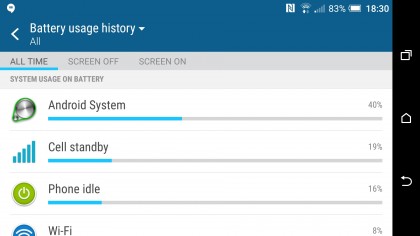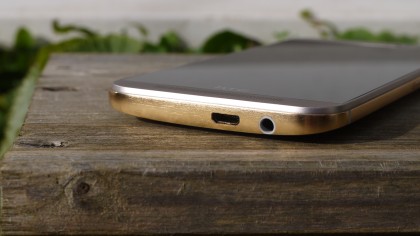Why you can trust TechRadar
Battery life on the HTC One M9 should be brilliant in comparison to what's been before. With the HTC One M8, the Snapdragon 801 chipset finally made an HTC phone decent at lasting throughout a day, and with a larger power pack and an improvement from Qualcomm things should have been awesome.
Sadly, they're not. I'm not saying that it's a problem and this phone won't last long enough to tap out a couple of tweets, but the performance hasn't been moved on much from previous efforts.
The issue is that the phone heats up really easily doing the most mundane of tasks. Anything that takes a little bit of wireless connection is a quick way to watch it drop, be it mobile data or listening to music over headphones.
Where most phones these days won't have much of an issue losing no more than 10% on my morning commute, even with a bit of video action, the One M9 has dropped as much as 17% through Bluetooth music streaming and emails, which is odd as this doesn't usually munch too much power.
The good news is Google's Android 6.0 gives you a good way of checking the problems, letting you shut down (or get rid of) the apps which are misbehaving.

However, in this case it's 'Google Services' which is one of the core power munchers. This incorporates elements fundamental to the running of the phone, which means there's not a lot to be done about it.
I usually see this in the first few days of reviewing, but the issue has pervaded. Hardcore testing - be it standby, heavy apps, web browsing and YouTube videos, for instance - has proven the HTC to be a poorer choice than the rest of the competition, with poorer background battery management.
This means you can't lean on the One M9 too heavily for playing games or watching videos, which is irritating if you want to have a little bit of battery left at the end of the day.
Gaming is really heavy on the battery, with a quick 15 minute game sometimes sucking 10% juice - although the issue is often that mobile games these days are constantly communicating with servers for online play or in app purchases, which hurts the battery.
Running TechRadar's standard battery test on the One M9, where we looped a 90 minute full HD video at maximum brightness showed that the M9 was one of the worst performers of recent times, with 24% of the battery disappearing - though I should note that this represents a 7% improvement on the same test we ran near the phone's launch. HTC and Google appear to have improved matters.
Still, if you consider that the LG G Flex 2, another big phone on the market with the Snapdragon 810 chipset, only lost 13% in the same test, then you'll see that there's something fundamentally inefficient going on with the software here.
That seems to be borne out by running the same test on Lollipop-equipped HTC One M8 and HTC One M7 handsets, which managed 24% and 30% respectively - and the phone from 2013 had barely enough battery to make it through the day too. This shows that HTC effectively stood still in battery life terms from 2013 to 2015, even with the larger capacity and theoretically more efficient processor of the M9.
As I said, the One M9's battery does appear to have improved since the early days, but that's only resulted in parity with the One M8, which can be had for significantly less than its successor these days, and that's just not good enough.

The Android 6.0 update appears to have brought some benefits, but only really in terms of idle time. Leaving the phone more or less untouched, with only extremely limited usage (as in, not using it as my main phone for a time), I found that the phone could last through a good three days.
That's doubtless thanks to Google's Doze feature, which was introduced with Marshmallow. Doze minimizes power usage when the phone is still and in sleep mode, and it really works. Of course, this benefit is largely nullified if you use your phone with any kind of regularity.
The other big thing here is QuickCharge 2.0 – although this offers a pretty amazing 60% charge in just 30 mins, the charger in the box isn't QuickCharge enabled to get the maximum speeds on offer.
This is just ludicrous – I thought by this point that they'd be standard as the tech began appearing in phones in 2014. It's really frustrating that you'll need to spend so much more given this is an already expensive phone relative to its specs.

Gareth has been part of the consumer technology world in a career spanning three decades. He started life as a staff writer on the fledgling TechRadar, and has grew with the site (primarily as phones, tablets and wearables editor) until becoming Global Editor in Chief in 2018. Gareth has written over 4,000 articles for TechRadar, has contributed expert insight to a number of other publications, chaired panels on zeitgeist technologies, presented at the Gadget Show Live as well as representing the brand on TV and radio for multiple channels including Sky, BBC, ITV and Al-Jazeera. Passionate about fitness, he can bore anyone rigid about stress management, sleep tracking, heart rate variance as well as bemoaning something about the latest iPhone, Galaxy or OLED TV.
